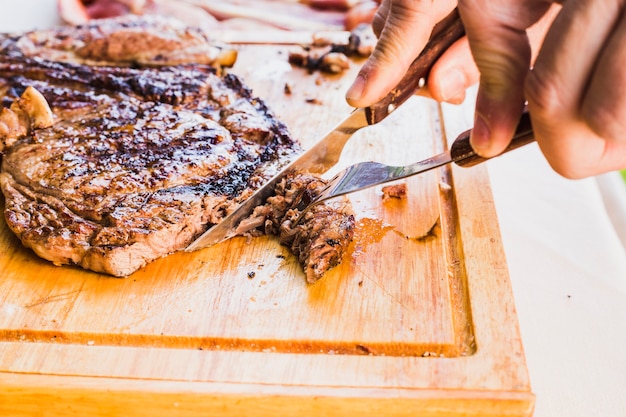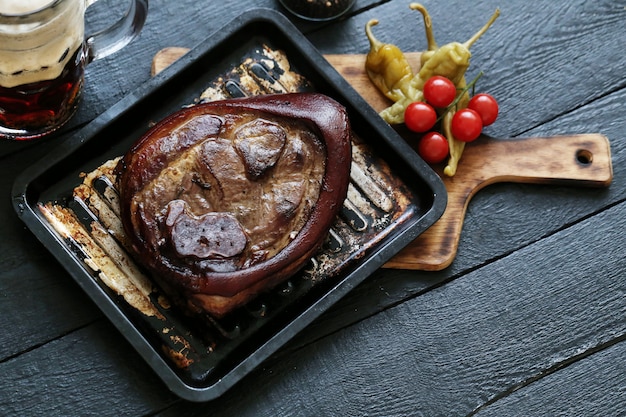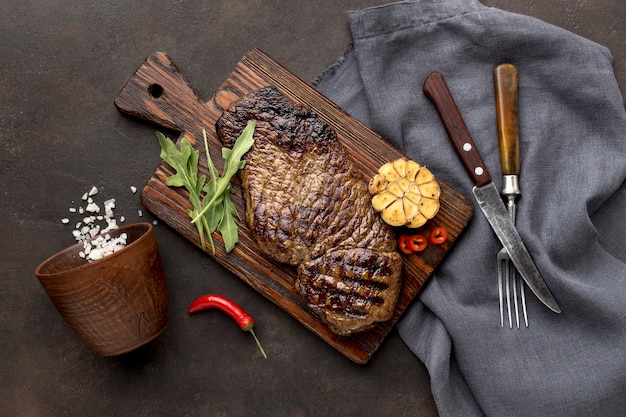(Part 1) The Cut: Choosing the Right Top Sirloin

What is Top Sirloin?
Top sirloin is a cut of beef taken from the loin, which runs along the back of the cow. It's known for being lean, flavorful, and a great value for your money. Compared to other cuts like ribeye or tenderloin, top sirloin has a slightly tougher texture but still cooks up beautifully when done right. Think of it as a budget-friendly alternative that doesn't compromise on taste.
The Different Types of Top Sirloin
Top sirloin comes in various cuts, each with its unique characteristics. You'll find:
- Top Sirloin Steak: This is the most common cut, a thick, rectangular piece of meat perfect for grilling, pan-frying, or broiling. It's versatile and can be enjoyed as a single serving or cut into smaller portions for sharing.
- Top Sirloin Cap: Also known as "petite tender" or "culotte", this cut is found at the top of the top sirloin, near the tenderloin. It's incredibly tender and often sold as individual portions. Think of it as a smaller, more delicate version of the top sirloin steak.
- Top sirloin roast: A larger cut, perfect for roasting in the oven or grilling over low heat. It's often found as a whole roast or cut into individual steaks. This cut is ideal for feeding a crowd or for those who prefer a more substantial meal.
choosing the right cut
When choosing your top sirloin, look for a piece with good marbling. Marbling refers to the streaks of fat within the meat, which contribute to flavour and juiciness. Think of it like a natural flavour enhancer. Avoid cuts with too much fat, as this can lead to a greasy steak. You want a balance – enough fat for flavour, but not so much that it overwhelms the meat.
Another important factor is the colour of the meat. The meat should be firm to the touch and have a bright red colour, indicating freshness. If you see any discoloration or signs of spoilage, it's best to choose another cut.
I always try to get my top sirloin from a local butcher or a trusted grocery store. They can help you choose the perfect cut and even advise you on cooking methods. Plus, they often have special cuts that you won't find at your average supermarket. It's worth the extra effort to get the best quality meat.
(Part 2) Preparation: Getting Ready for the perfect steak

Bringing the Steak to Room Temperature
This is a crucial step that many people overlook. Leaving your steak out on the counter for about 30 minutes before cooking allows the meat to warm up to room temperature. This results in a more even cook, preventing the inside from being cold while the outside is overcooked. Imagine a perfectly cooked steak, with a juicy, tender centre and a delicious, crispy crust. That's what you get when you bring your steak to room temperature.
I learned this little trick from a seasoned chef, and let me tell you, it makes a world of difference. It's especially important for thicker steaks, as they take longer to cook through. Just make sure you keep it in a safe place on your counter, away from any heat sources or pests.
Seasoning Your Steak
You don't need to get fancy with seasoning. Salt and pepper are all you really need. Salt helps to draw out moisture and flavour, while pepper adds a bit of spice. It's a classic combination for a reason.
I like to season my steak liberally with salt and pepper about 30 minutes before cooking. This allows the seasoning to penetrate the meat and really bring out the flavour. The salt helps to break down the muscle fibres, making the steak more tender. I prefer coarse kosher salt for this, as it dissolves slower and creates a more even crust.
The Importance of Resting
After cooking, let your steak rest for at least 5 minutes before slicing and serving. This allows the juices to redistribute throughout the meat, resulting in a juicier, more tender steak. Think of it as a crucial step in achieving that perfect balance of texture and flavour.
I find that 5 minutes is enough for a medium-thick steak, but for thicker cuts, you might want to let it rest for up to 10 minutes. You can use this time to prepare your sides or make a sauce, ensuring that your steak is ready to serve at the perfect moment.
(Part 3) Cooking Methods: Exploring Different Techniques

Grilling
Grilling is my go-to method for cooking top sirloin. It's quick, easy, and adds a beautiful smoky flavour to the meat. The char marks and smoky aroma elevate the steak to a whole new level. I always preheat my grill to high heat and use a good-quality grill grate. This helps to ensure even cooking and prevents the steak from sticking.
When grilling, sear the steak for 2-3 minutes per side to create a nice crust, then reduce the heat to medium and cook for another 4-6 minutes per side for a medium-rare steak. If you like your steak more well-done, cook it for longer. Remember, it's always better to undercook than overcook. You can always cook it a bit longer, but you can't un-cook a steak that's been overdone.
Pan-Frying
Pan-frying is another excellent method for cooking top sirloin. It's great if you don't have a grill or if you prefer a more even cook. Pan-frying allows you to control the heat more precisely, resulting in a perfectly cooked steak every time. Use a heavy-bottomed pan and heat it over high heat. Add a bit of oil and sear the steak for 2-3 minutes per side. This will create a beautiful crust that locks in the juices and adds flavour.
Once seared, reduce the heat to medium and cook for another 4-6 minutes per side for a medium-rare steak. If you like your steak more well-done, cook it for longer. The key is to pay attention to the internal temperature of the steak to ensure it's cooked to your liking.
Oven-Roasting
For a more tender and juicy steak, consider oven-roasting. This method is great for larger cuts or if you prefer a more hands-off approach. Preheat your oven to 400°F (200°C). Season your steak and place it on a baking sheet. Roast for 10-15 minutes for a medium-rare steak.
Again, if you prefer a more well-done steak, cook it for longer. The oven heat will evenly cook the steak from all sides, resulting in a tender, juicy, and flavourful result.
(Part 4) cooking times and Temperatures
Understanding Doneness
Knowing how to cook your steak to the desired level of doneness is key. It's all about finding that perfect balance between a juicy centre and a delicious crust. Here's a guide to the different levels of doneness and their corresponding internal temperatures:
| Doneness | Internal Temperature (°F) |
|---|---|
| Rare | 125-130 |
| Medium-Rare | 130-135 |
| Medium | 140-145 |
| Medium-Well | 150-155 |
| Well-Done | 160 |
I prefer my steaks medium-rare, with a nice juicy centre. The steak should be slightly pink in the middle, with a delicious crispy crust. But don't be afraid to experiment and find what you like best. Everyone has their own preferences, so explore and discover your perfect level of doneness.
Using a meat thermometer
A meat thermometer is an invaluable tool for ensuring your steak is cooked to perfection. It takes the guesswork out of cooking and ensures that your steak is cooked to your liking. Insert the thermometer into the thickest part of the steak, avoiding bone or fat. It should read the desired temperature.
I always use a meat thermometer, especially for thicker steaks. It helps me avoid overcooking and ensures that the steak is cooked evenly throughout. It's a small investment that pays off in the form of consistently delicious results.
Resting Time
After cooking, let your steak rest for 5-10 minutes before slicing. This allows the juices to redistribute throughout the meat, resulting in a more tender, juicy steak. The resting period is essential for achieving that perfectly juicy and tender steak.
I've learned that a little patience goes a long way. Resist the temptation to cut into your steak right away; let it rest and enjoy the delicious results. It's a small step that makes a big difference in the overall quality of your steak.
(Part 5) steak sauces and Accompaniments
The Magic of Sauce
A good steak sauce can elevate a great steak to a whole new level. It adds complexity and richness, complementing the natural flavours of the meat. There are endless possibilities when it comes to steak sauces, from classic to contemporary, depending on your preference.
- Classic Béarnaise: This creamy, tangy sauce made with egg yolks, butter, and herbs is a classic for a reason. It's a rich and indulgent sauce that pairs beautifully with grilled or pan-fried steak.
- Peppercorn Sauce: A simple yet flavorful sauce made with cracked peppercorns, butter, and wine. It's a bold and aromatic sauce that adds a kick to your steak.
- Mushroom Sauce: A rich and earthy sauce made with mushrooms, wine, and cream. It's a perfect complement to grilled or roasted steak, adding depth and complexity to the dish.
Personally, I'm a fan of a simple garlic herb butter sauce. It's easy to make and pairs perfectly with top sirloin. Just melt butter in a pan, add minced garlic and your favourite herbs, and season with salt and pepper. It's a versatile sauce that can be adjusted to your liking, using different herbs and spices to create unique flavour profiles.
Sides to Complete Your Meal
No steak is complete without a few delicious sides. They provide a balance of flavours and textures, making the meal more satisfying and enjoyable.
- mashed potatoes: A classic comfort food that pairs perfectly with steak. Creamy and comforting, it provides a delicious contrast to the richness of the steak.
- Roasted Vegetables: A healthy and flavorful option that adds a touch of colour to your plate. Think roasted asparagus, Brussels sprouts, or broccoli.
- Green Salad: A refreshing and light side that balances the richness of the steak. A simple green salad with a vinaigrette dressing can be a perfect complement to a hearty steak meal.
Experiment with different combinations to find what you enjoy most. Don't be afraid to get creative and try new things.
(Part 6) Serving Your steak masterpiece
Slicing and Presentation
Once your steak has rested, it's time to slice it up and plate it. I find that slicing against the grain helps to tenderize the meat and make it easier to chew.
To slice your steak, use a sharp knife and cut into thin slices, about 1/2 inch thick. Arrange the slices on a platter, and don't forget to add a dollop of sauce and a sprig of fresh herbs for a touch of elegance. A simple presentation can make a big difference, transforming your steak from just a meal to a culinary experience.
Garnish for That Extra Touch
A simple garnish can elevate your steak from good to amazing. A few simple touches can transform a simple dish into a beautiful and delicious presentation.
- Fresh herbs: A sprig of rosemary, thyme, or parsley adds a touch of colour and fragrance. It adds a visual appeal and complements the flavours of the steak.
- Lemon wedges: A squeeze of lemon juice adds a touch of acidity and brightens the flavour. It adds a refreshing contrast to the richness of the steak.
- Roasted garlic cloves: A delightful and flavourful addition that adds a touch of sweetness. It adds a subtle sweetness and complements the savory flavours of the steak.
Let your creativity run wild and have fun with it. Don't be afraid to experiment and find what works best for you.
(Part 7) Tips for Success: Avoiding Common Mistakes
Overcooking the Steak
One of the biggest mistakes people make is overcooking their steak. A well-done steak is dry and tough, so aim for a medium-rare or medium level of doneness. It's all about finding that perfect balance between a juicy centre and a delicious crust.
Always use a meat thermometer to check the internal temperature and avoid overcooking. It's your best friend in the kitchen, ensuring that your steak is cooked to your liking every time.
Not Resting the Steak
Resting your steak after cooking is essential. It allows the juices to redistribute throughout the meat, resulting in a more tender, juicy steak. It's a crucial step in achieving that perfect balance of texture and flavour.
Don't rush the process. Let your steak rest for at least 5-10 minutes before slicing and serving. It's worth the wait for the incredible results.
Using a Dull Knife
A dull knife can make slicing your steak a frustrating experience. It can tear the meat and make it look messy.
Invest in a good-quality sharp knife and always sharpen it regularly. A sharp knife makes slicing easy, resulting in beautifully sliced steak and a more enjoyable dining experience.
(Part 8) FAQs: Your Steak Questions Answered
1. What is the best way to store top sirloin?
Store your top sirloin in the refrigerator, wrapped tightly in plastic wrap or foil. This helps to keep the meat fresh and prevents it from drying out. It can be stored for up to 3-4 days. You can also freeze top sirloin for up to 3-4 months. Just be sure to thaw it in the refrigerator before cooking. Thaw it slowly in the refrigerator to ensure even thawing and prevent freezer burn.
2. How do I know if my top sirloin is bad?
If your top sirloin has a sour smell, a slimy texture, or a dull colour, it's best to discard it. Trust your senses. If it looks or smells off, it's not worth risking your health. Always check your meat for signs of spoilage before cooking.
3. Can I use top sirloin for steak tartare?
While technically possible, it's not recommended. Top sirloin is a lean cut of meat, and steak tartare requires a fattier cut, like ribeye or tenderloin. You want a cut that has enough fat to provide the richness and flavour needed for a delicious steak tartare. For a truly satisfying steak tartare, choose a cut that is known for its marbling and richness.
4. Can I marinate top sirloin?
Yes, you can absolutely marinate top sirloin. It's a great way to add flavour and tenderness to the meat. Marinate your steak for at least 30 minutes, but up to 24 hours, in your favourite marinade. Experiment with different marinades to find what you enjoy most.
5. What is the best way to cook top sirloin for a crowd?
For a crowd, consider grilling your top sirloin steaks over medium heat. This allows you to cook multiple steaks simultaneously, ensuring that everyone gets a delicious piece. You can also roast your top sirloin in the oven at a low temperature, but it will take longer to cook.
Now, go forth and conquer the world of top sirloin! With these tips and techniques, you'll be a steak-cooking superstar in no time. Remember to have fun and experiment with different cooking methods and sauces. The possibilities are endless, so go for it!Everyone is watching

Corn on the Cob: The Ultimate Guide to Perfectly Cooked Ears
Healthy MealsAh, corn on the cob. Just the name evokes images of sunny days, barbecues, and that sweet, juicy flavour that ...

Perfect Pork Roast Oven Cooking Time: A Guide to Delicious Results
Healthy MealsThere's something truly satisfying about a perfectly roasted pork. The aroma alone is enough to make your mout...

Scallops: The Ultimate Guide to Perfect Cooking
Healthy MealsAh, scallops. Those delicate, sweet, and utterly delicious morsels of the sea. They hold a special place in my...

Spaghetti Squash: The Ultimate Guide to Cooking and Serving
Healthy MealsRemember that time you saw spaghetti squash at the supermarket, looking all bumpy and strange, and thought, "W...

Ham Cooking Time: How Long to Bake, Smoke, or Boil a Delicious Ham
Healthy MealsAh, ham. It's a classic, isn't it? A real crowd-pleaser, especially around holidays. And when done right, it'...
